Buncefield Fire Incident: Health, Safety, and Environmental Analysis
VerifiedAdded on 2022/08/24
|19
|5317
|31
Report
AI Summary
This report provides a comprehensive analysis of the Buncefield fire incident, which occurred in 2005 at the Hertfordshire Oil Storage Terminal (HOSL) in England. The report delves into the causes of the disaster, including the failure of the Automatic Tank Gauge (ATG) and Independent High-Level Switch (IHLS), work pressure on staff, and lack of training, highlighting the importance of health and safety management. It explores the environmental and health impacts, such as air and water pollution, respiratory issues, and economic losses. The study also examines relevant health and safety regulations, including the Health and Safety at Work Act 1974 and COMAH regulations. The analysis includes the application of the Entropy Model and HAZOP for risk assessment. The report concludes with recommendations for improved safety practices and management principles in the oil and gas industry.
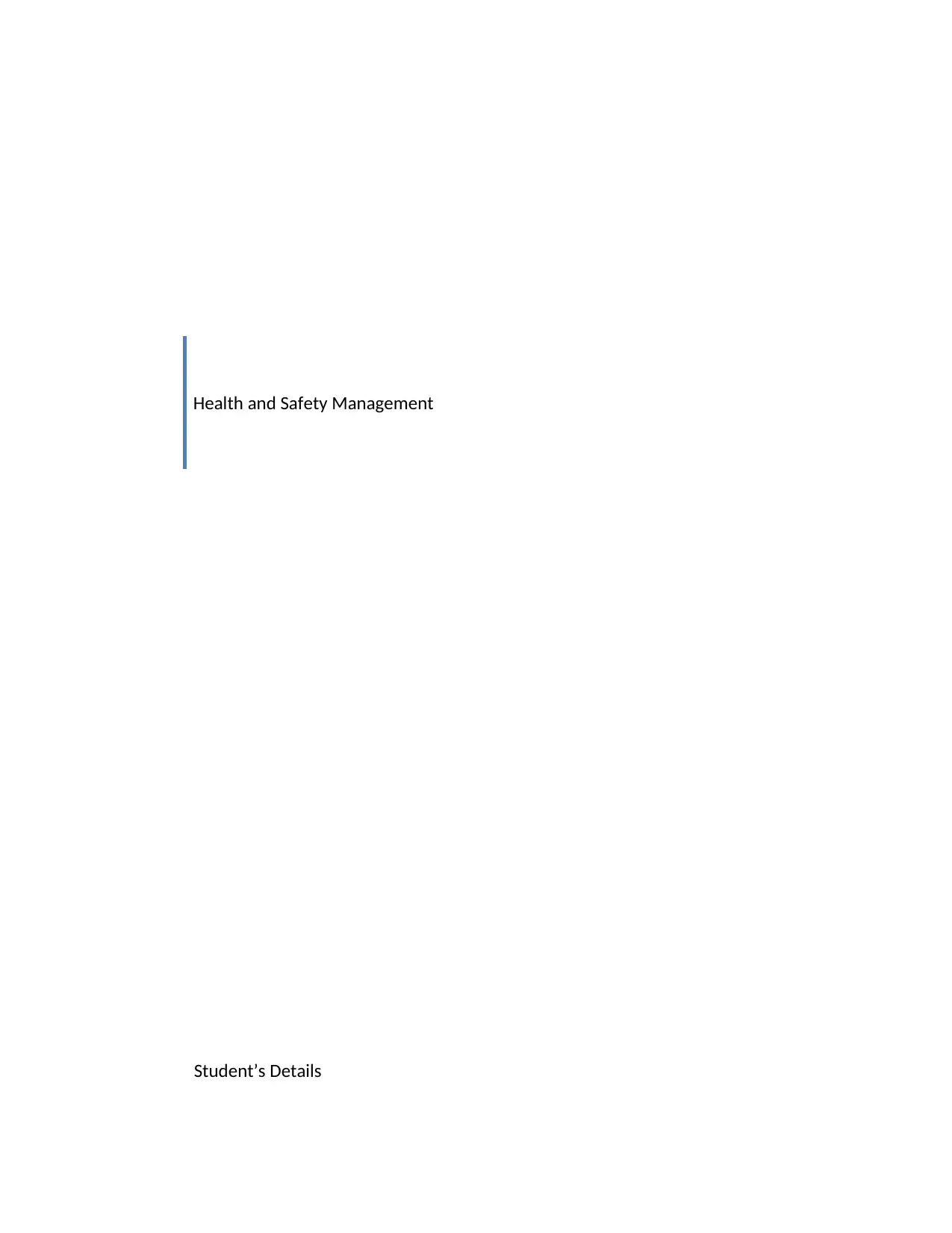
Health and Safety Management
Student’s Details
Student’s Details
Paraphrase This Document
Need a fresh take? Get an instant paraphrase of this document with our AI Paraphraser

HSM
Contents
Introduction......................................................................................................................................2
Health and Safety Issues..................................................................................................................3
Health and Safety Issues: Buncefield..........................................................................................3
Failure of ATG and IHLS............................................................................................................3
Work pressure on the staff...........................................................................................................4
Absence of Training....................................................................................................................5
Environmental and health impact....................................................................................................5
Comparison of health, safety, and environment theory and practice..............................................8
Guidance of HSC.........................................................................................................................8
Health and safety regulation........................................................................................................9
Health and Safety at Work Act 1974.......................................................................................9
Workplace Regulations 1992...................................................................................................9
The Offshore Installations Regulations 2005........................................................................10
The Offshore Installations Regulations 1995........................................................................10
Offshore Safety Act 1992......................................................................................................10
The Control of Major Accident Hazards Regulations 1999..................................................10
Health and safety Act 2008....................................................................................................11
Compression of Buncefield Fire accident and ignorance of safety and regulation...................11
The Entropy Model................................................................................................................12
HAZOP..................................................................................................................................12
Recommendations..........................................................................................................................13
Conclusion.....................................................................................................................................14
Bibliography..................................................................................................................................16
Contents
Introduction......................................................................................................................................2
Health and Safety Issues..................................................................................................................3
Health and Safety Issues: Buncefield..........................................................................................3
Failure of ATG and IHLS............................................................................................................3
Work pressure on the staff...........................................................................................................4
Absence of Training....................................................................................................................5
Environmental and health impact....................................................................................................5
Comparison of health, safety, and environment theory and practice..............................................8
Guidance of HSC.........................................................................................................................8
Health and safety regulation........................................................................................................9
Health and Safety at Work Act 1974.......................................................................................9
Workplace Regulations 1992...................................................................................................9
The Offshore Installations Regulations 2005........................................................................10
The Offshore Installations Regulations 1995........................................................................10
Offshore Safety Act 1992......................................................................................................10
The Control of Major Accident Hazards Regulations 1999..................................................10
Health and safety Act 2008....................................................................................................11
Compression of Buncefield Fire accident and ignorance of safety and regulation...................11
The Entropy Model................................................................................................................12
HAZOP..................................................................................................................................12
Recommendations..........................................................................................................................13
Conclusion.....................................................................................................................................14
Bibliography..................................................................................................................................16
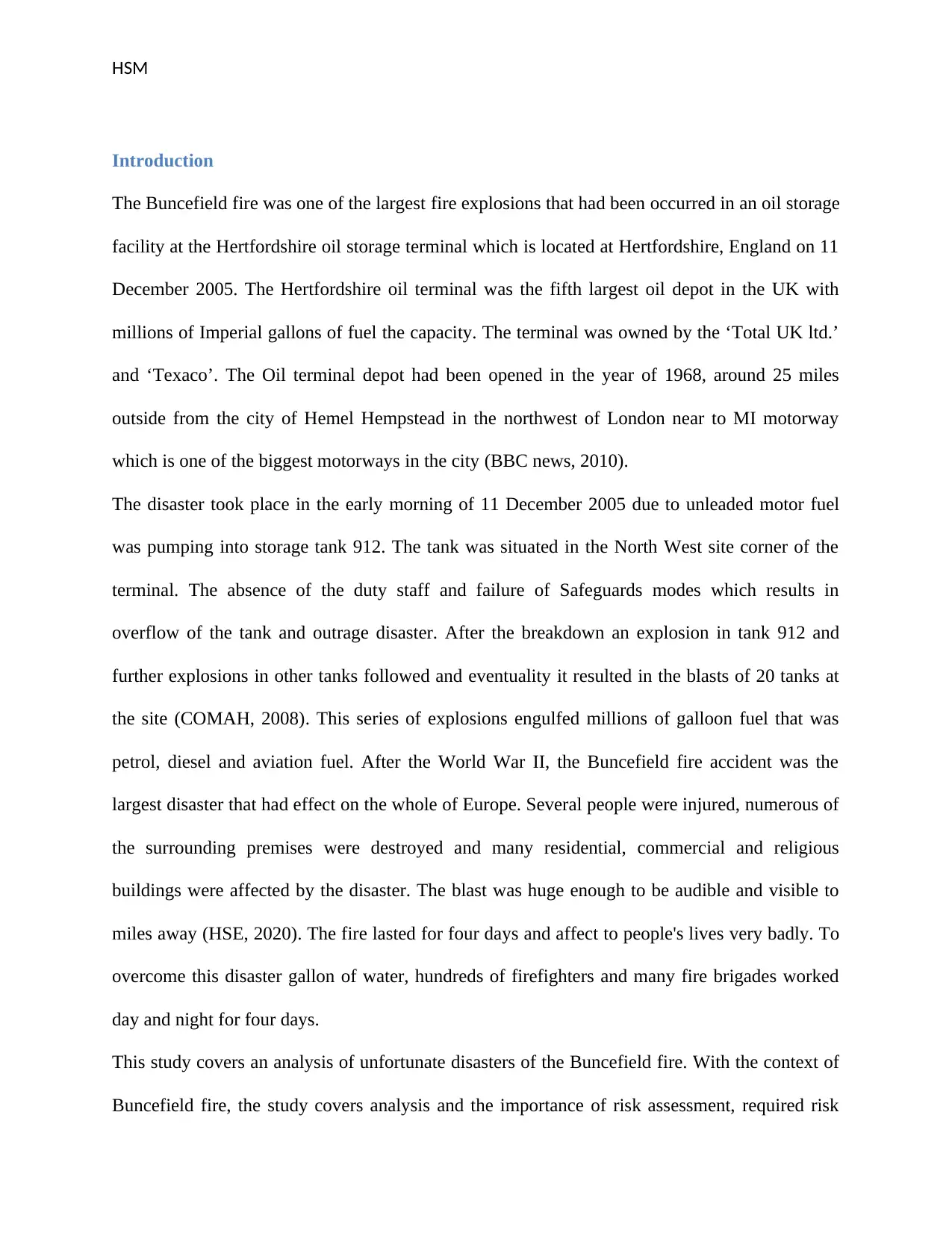
HSM
Introduction
The Buncefield fire was one of the largest fire explosions that had been occurred in an oil storage
facility at the Hertfordshire oil storage terminal which is located at Hertfordshire, England on 11
December 2005. The Hertfordshire oil terminal was the fifth largest oil depot in the UK with
millions of Imperial gallons of fuel the capacity. The terminal was owned by the ‘Total UK ltd.’
and ‘Texaco’. The Oil terminal depot had been opened in the year of 1968, around 25 miles
outside from the city of Hemel Hempstead in the northwest of London near to MI motorway
which is one of the biggest motorways in the city (BBC news, 2010).
The disaster took place in the early morning of 11 December 2005 due to unleaded motor fuel
was pumping into storage tank 912. The tank was situated in the North West site corner of the
terminal. The absence of the duty staff and failure of Safeguards modes which results in
overflow of the tank and outrage disaster. After the breakdown an explosion in tank 912 and
further explosions in other tanks followed and eventuality it resulted in the blasts of 20 tanks at
the site (COMAH, 2008). This series of explosions engulfed millions of galloon fuel that was
petrol, diesel and aviation fuel. After the World War II, the Buncefield fire accident was the
largest disaster that had effect on the whole of Europe. Several people were injured, numerous of
the surrounding premises were destroyed and many residential, commercial and religious
buildings were affected by the disaster. The blast was huge enough to be audible and visible to
miles away (HSE, 2020). The fire lasted for four days and affect to people's lives very badly. To
overcome this disaster gallon of water, hundreds of firefighters and many fire brigades worked
day and night for four days.
This study covers an analysis of unfortunate disasters of the Buncefield fire. With the context of
Buncefield fire, the study covers analysis and the importance of risk assessment, required risk
Introduction
The Buncefield fire was one of the largest fire explosions that had been occurred in an oil storage
facility at the Hertfordshire oil storage terminal which is located at Hertfordshire, England on 11
December 2005. The Hertfordshire oil terminal was the fifth largest oil depot in the UK with
millions of Imperial gallons of fuel the capacity. The terminal was owned by the ‘Total UK ltd.’
and ‘Texaco’. The Oil terminal depot had been opened in the year of 1968, around 25 miles
outside from the city of Hemel Hempstead in the northwest of London near to MI motorway
which is one of the biggest motorways in the city (BBC news, 2010).
The disaster took place in the early morning of 11 December 2005 due to unleaded motor fuel
was pumping into storage tank 912. The tank was situated in the North West site corner of the
terminal. The absence of the duty staff and failure of Safeguards modes which results in
overflow of the tank and outrage disaster. After the breakdown an explosion in tank 912 and
further explosions in other tanks followed and eventuality it resulted in the blasts of 20 tanks at
the site (COMAH, 2008). This series of explosions engulfed millions of galloon fuel that was
petrol, diesel and aviation fuel. After the World War II, the Buncefield fire accident was the
largest disaster that had effect on the whole of Europe. Several people were injured, numerous of
the surrounding premises were destroyed and many residential, commercial and religious
buildings were affected by the disaster. The blast was huge enough to be audible and visible to
miles away (HSE, 2020). The fire lasted for four days and affect to people's lives very badly. To
overcome this disaster gallon of water, hundreds of firefighters and many fire brigades worked
day and night for four days.
This study covers an analysis of unfortunate disasters of the Buncefield fire. With the context of
Buncefield fire, the study covers analysis and the importance of risk assessment, required risk
⊘ This is a preview!⊘
Do you want full access?
Subscribe today to unlock all pages.

Trusted by 1+ million students worldwide

HSM
management and communication. With emphasizing the Buncefield fire accident the study also
discovers the common hazards, consequences and potential control measures of the oil and gas
industry. This discussion also covers health, safety and environmental legislation.
Recommendation for healthy and good management principles in the reference of the gas
industry also stated in the study.
Health and Safety Issues
Health and safety issues are important parameters in the oil and natural gas industry. OGUK
members are committed to ensuring the safety and security of people in the industry and
safeguarding the environment. OGUK organization is tirelessly working to avoid potential
accidents and misshaping in the industry. To foster and promote the working environment and
safety practices OGUK organization ensures training and learning programs, improves research
and fair communication and information sharing with the members in the industry. Because, oil
and gas industry comprises some hazardous factors they may lead to accidents and misshape
such as involvement of heavy equipment, high-pressure equipment, dangerous materials, and
high temperatures at the worksite. Thus the OGUK and HSE are continuously working to decline
illness and injuries in the industry (OGUK, 2019).
Health and Safety Issues: Buncefield
After the Buncefield accident, the Health and Safety Commission of the country appointed an
independent investigation board to identify the causes and accountable for the disaster.
Failure of ATG and IHLS
The immediate cause of this fatal disaster in HOSL was the failure of automatic tank gauge and
the independent high-level switch to operate as the fuel level in Tank 912 increased. This was a
management and communication. With emphasizing the Buncefield fire accident the study also
discovers the common hazards, consequences and potential control measures of the oil and gas
industry. This discussion also covers health, safety and environmental legislation.
Recommendation for healthy and good management principles in the reference of the gas
industry also stated in the study.
Health and Safety Issues
Health and safety issues are important parameters in the oil and natural gas industry. OGUK
members are committed to ensuring the safety and security of people in the industry and
safeguarding the environment. OGUK organization is tirelessly working to avoid potential
accidents and misshaping in the industry. To foster and promote the working environment and
safety practices OGUK organization ensures training and learning programs, improves research
and fair communication and information sharing with the members in the industry. Because, oil
and gas industry comprises some hazardous factors they may lead to accidents and misshape
such as involvement of heavy equipment, high-pressure equipment, dangerous materials, and
high temperatures at the worksite. Thus the OGUK and HSE are continuously working to decline
illness and injuries in the industry (OGUK, 2019).
Health and Safety Issues: Buncefield
After the Buncefield accident, the Health and Safety Commission of the country appointed an
independent investigation board to identify the causes and accountable for the disaster.
Failure of ATG and IHLS
The immediate cause of this fatal disaster in HOSL was the failure of automatic tank gauge and
the independent high-level switch to operate as the fuel level in Tank 912 increased. This was a
Paraphrase This Document
Need a fresh take? Get an instant paraphrase of this document with our AI Paraphraser

HSM
loss of ‘primary’ suppression. Both automatic tank gauge and the independent high-level switch
were supposed to automatically close down on overflow of the tank. In the disaster of HOSL, an
automatic tank gauge was jammed, and IHLS was not working properly for the months. Another
major health issue in HOSL has been identified as being poor management system. The
management system in HOSL related to filling the tanks was deficient and did not be properly
followed. The switch was not properly working for the moths, so it was managers' or supervisors'
responsibility to inform users to change the critical key of the tank (COMAH, 2008).
Besides, the failure of the independent high-level switch at the same time also resulted in this
disaster. Site managers and supervisors and site operators in the company were having a poor
understanding of IHLS. They did not exercise for testing procedures, installation, and
implementation of IHLS. According to the safety measure of the company and OGUK, such
machinery and switch supposed to go through periodic tests and monitoring. In the company
managers, operating staff and ground staff all were aware of to replacement of ATG and IHLS. It
was bigger negligence of site managers and operating managers in this accident (HSE, 2012).
Work pressure on the staff
The staff of the company was suffering from acute work pressure at the worksite. There were
three pipelines to filling the oil and fuel worksite. The ground and controlling staff in the site was
able to control the flow and filling system, but they had a lack of control over the third pipelines
and flow rate. The site staff had insufficient to precisely manage the storage of incoming fuel.
The filling system of the tanks was also poorly defined. Lack of sufficient and equate staff,
operating and site managers are not able to predict working measures of UK Oil and petroleum
lines that outcome in unpredictable oil deliveries through those three pipelines. The top manager
loss of ‘primary’ suppression. Both automatic tank gauge and the independent high-level switch
were supposed to automatically close down on overflow of the tank. In the disaster of HOSL, an
automatic tank gauge was jammed, and IHLS was not working properly for the months. Another
major health issue in HOSL has been identified as being poor management system. The
management system in HOSL related to filling the tanks was deficient and did not be properly
followed. The switch was not properly working for the moths, so it was managers' or supervisors'
responsibility to inform users to change the critical key of the tank (COMAH, 2008).
Besides, the failure of the independent high-level switch at the same time also resulted in this
disaster. Site managers and supervisors and site operators in the company were having a poor
understanding of IHLS. They did not exercise for testing procedures, installation, and
implementation of IHLS. According to the safety measure of the company and OGUK, such
machinery and switch supposed to go through periodic tests and monitoring. In the company
managers, operating staff and ground staff all were aware of to replacement of ATG and IHLS. It
was bigger negligence of site managers and operating managers in this accident (HSE, 2012).
Work pressure on the staff
The staff of the company was suffering from acute work pressure at the worksite. There were
three pipelines to filling the oil and fuel worksite. The ground and controlling staff in the site was
able to control the flow and filling system, but they had a lack of control over the third pipelines
and flow rate. The site staff had insufficient to precisely manage the storage of incoming fuel.
The filling system of the tanks was also poorly defined. Lack of sufficient and equate staff,
operating and site managers are not able to predict working measures of UK Oil and petroleum
lines that outcome in unpredictable oil deliveries through those three pipelines. The top manager
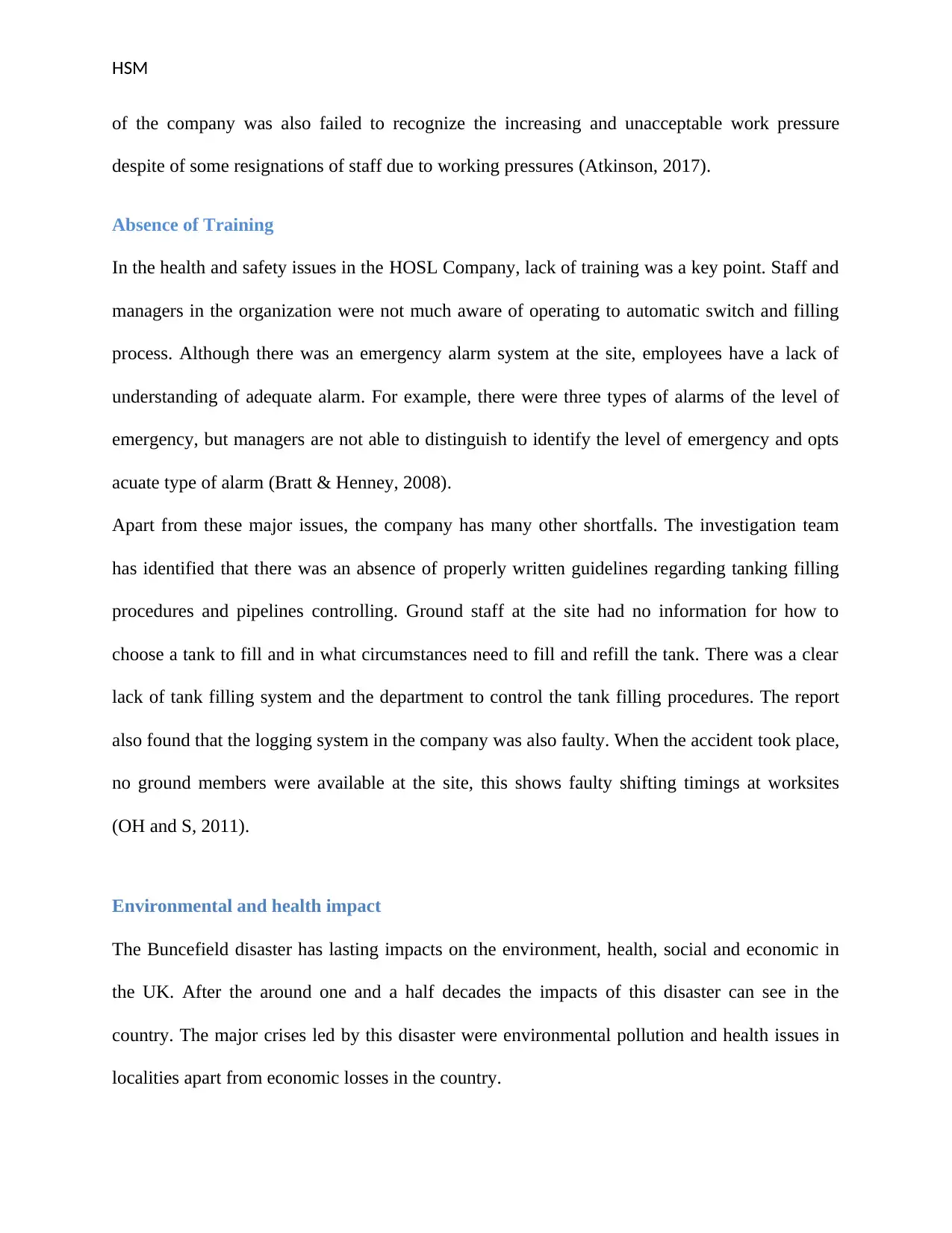
HSM
of the company was also failed to recognize the increasing and unacceptable work pressure
despite of some resignations of staff due to working pressures (Atkinson, 2017).
Absence of Training
In the health and safety issues in the HOSL Company, lack of training was a key point. Staff and
managers in the organization were not much aware of operating to automatic switch and filling
process. Although there was an emergency alarm system at the site, employees have a lack of
understanding of adequate alarm. For example, there were three types of alarms of the level of
emergency, but managers are not able to distinguish to identify the level of emergency and opts
acuate type of alarm (Bratt & Henney, 2008).
Apart from these major issues, the company has many other shortfalls. The investigation team
has identified that there was an absence of properly written guidelines regarding tanking filling
procedures and pipelines controlling. Ground staff at the site had no information for how to
choose a tank to fill and in what circumstances need to fill and refill the tank. There was a clear
lack of tank filling system and the department to control the tank filling procedures. The report
also found that the logging system in the company was also faulty. When the accident took place,
no ground members were available at the site, this shows faulty shifting timings at worksites
(OH and S, 2011).
Environmental and health impact
The Buncefield disaster has lasting impacts on the environment, health, social and economic in
the UK. After the around one and a half decades the impacts of this disaster can see in the
country. The major crises led by this disaster were environmental pollution and health issues in
localities apart from economic losses in the country.
of the company was also failed to recognize the increasing and unacceptable work pressure
despite of some resignations of staff due to working pressures (Atkinson, 2017).
Absence of Training
In the health and safety issues in the HOSL Company, lack of training was a key point. Staff and
managers in the organization were not much aware of operating to automatic switch and filling
process. Although there was an emergency alarm system at the site, employees have a lack of
understanding of adequate alarm. For example, there were three types of alarms of the level of
emergency, but managers are not able to distinguish to identify the level of emergency and opts
acuate type of alarm (Bratt & Henney, 2008).
Apart from these major issues, the company has many other shortfalls. The investigation team
has identified that there was an absence of properly written guidelines regarding tanking filling
procedures and pipelines controlling. Ground staff at the site had no information for how to
choose a tank to fill and in what circumstances need to fill and refill the tank. There was a clear
lack of tank filling system and the department to control the tank filling procedures. The report
also found that the logging system in the company was also faulty. When the accident took place,
no ground members were available at the site, this shows faulty shifting timings at worksites
(OH and S, 2011).
Environmental and health impact
The Buncefield disaster has lasting impacts on the environment, health, social and economic in
the UK. After the around one and a half decades the impacts of this disaster can see in the
country. The major crises led by this disaster were environmental pollution and health issues in
localities apart from economic losses in the country.
⊘ This is a preview!⊘
Do you want full access?
Subscribe today to unlock all pages.

Trusted by 1+ million students worldwide
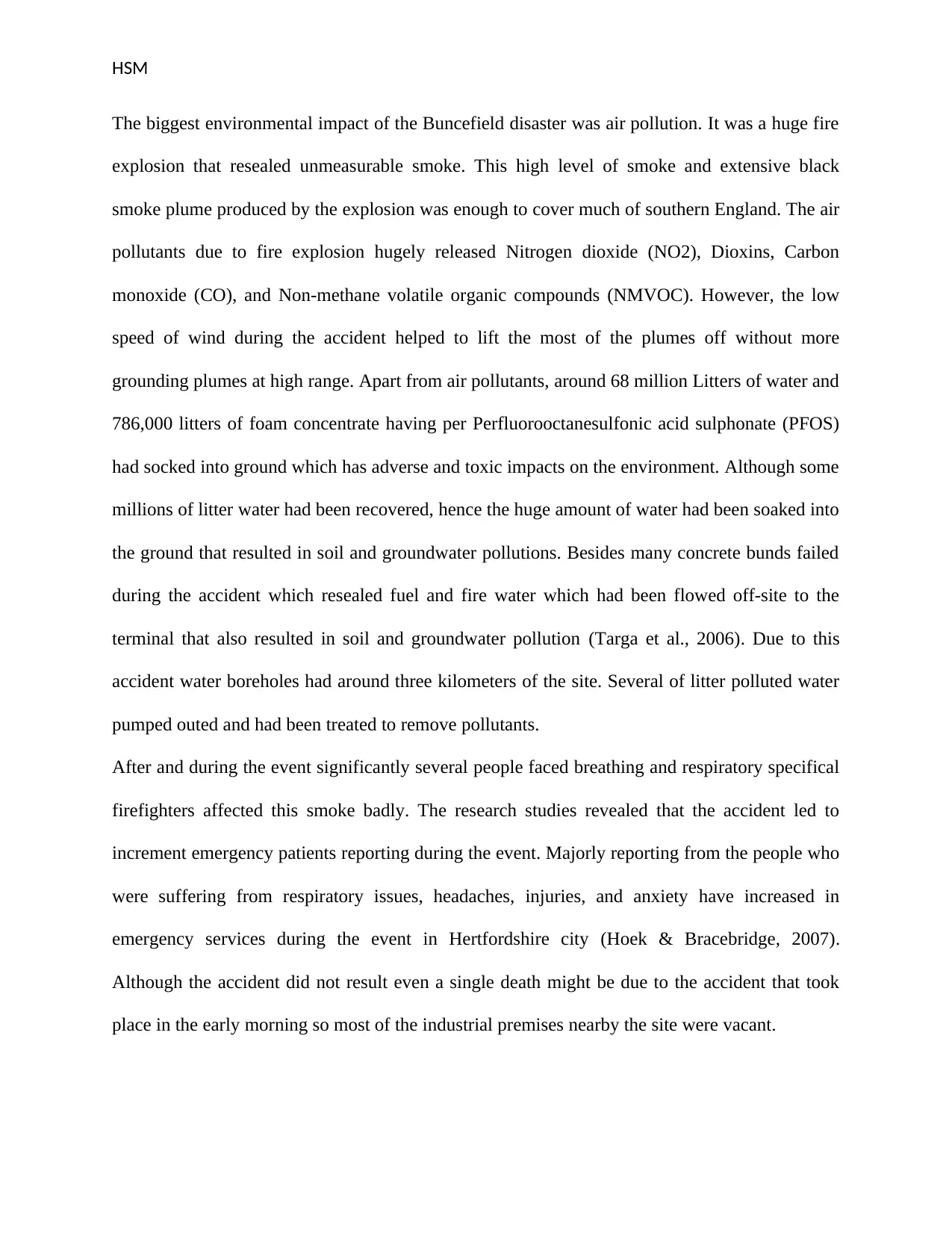
HSM
The biggest environmental impact of the Buncefield disaster was air pollution. It was a huge fire
explosion that resealed unmeasurable smoke. This high level of smoke and extensive black
smoke plume produced by the explosion was enough to cover much of southern England. The air
pollutants due to fire explosion hugely released Nitrogen dioxide (NO2), Dioxins, Carbon
monoxide (CO), and Non-methane volatile organic compounds (NMVOC). However, the low
speed of wind during the accident helped to lift the most of the plumes off without more
grounding plumes at high range. Apart from air pollutants, around 68 million Litters of water and
786,000 litters of foam concentrate having per Perfluorooctanesulfonic acid sulphonate (PFOS)
had socked into ground which has adverse and toxic impacts on the environment. Although some
millions of litter water had been recovered, hence the huge amount of water had been soaked into
the ground that resulted in soil and groundwater pollutions. Besides many concrete bunds failed
during the accident which resealed fuel and fire water which had been flowed off-site to the
terminal that also resulted in soil and groundwater pollution (Targa et al., 2006). Due to this
accident water boreholes had around three kilometers of the site. Several of litter polluted water
pumped outed and had been treated to remove pollutants.
After and during the event significantly several people faced breathing and respiratory specifical
firefighters affected this smoke badly. The research studies revealed that the accident led to
increment emergency patients reporting during the event. Majorly reporting from the people who
were suffering from respiratory issues, headaches, injuries, and anxiety have increased in
emergency services during the event in Hertfordshire city (Hoek & Bracebridge, 2007).
Although the accident did not result even a single death might be due to the accident that took
place in the early morning so most of the industrial premises nearby the site were vacant.
The biggest environmental impact of the Buncefield disaster was air pollution. It was a huge fire
explosion that resealed unmeasurable smoke. This high level of smoke and extensive black
smoke plume produced by the explosion was enough to cover much of southern England. The air
pollutants due to fire explosion hugely released Nitrogen dioxide (NO2), Dioxins, Carbon
monoxide (CO), and Non-methane volatile organic compounds (NMVOC). However, the low
speed of wind during the accident helped to lift the most of the plumes off without more
grounding plumes at high range. Apart from air pollutants, around 68 million Litters of water and
786,000 litters of foam concentrate having per Perfluorooctanesulfonic acid sulphonate (PFOS)
had socked into ground which has adverse and toxic impacts on the environment. Although some
millions of litter water had been recovered, hence the huge amount of water had been soaked into
the ground that resulted in soil and groundwater pollutions. Besides many concrete bunds failed
during the accident which resealed fuel and fire water which had been flowed off-site to the
terminal that also resulted in soil and groundwater pollution (Targa et al., 2006). Due to this
accident water boreholes had around three kilometers of the site. Several of litter polluted water
pumped outed and had been treated to remove pollutants.
After and during the event significantly several people faced breathing and respiratory specifical
firefighters affected this smoke badly. The research studies revealed that the accident led to
increment emergency patients reporting during the event. Majorly reporting from the people who
were suffering from respiratory issues, headaches, injuries, and anxiety have increased in
emergency services during the event in Hertfordshire city (Hoek & Bracebridge, 2007).
Although the accident did not result even a single death might be due to the accident that took
place in the early morning so most of the industrial premises nearby the site were vacant.
Paraphrase This Document
Need a fresh take? Get an instant paraphrase of this document with our AI Paraphraser

HSM
This accident also led to huge economic losses in the country, especially for the company. Most
of the fuel at the site had been destroyed by the fire. The economic cost of the fair explosion has
been estimated at around 1.1 billion euro dollars. Water treatment, air treatment and repairing the
buildings also led to additional costs for many years in the country. Industrial and domestic
properties had been destroyed by the blast. Many glasses of doors and windows of industrial and
domestic buildings had been destroyed. The fair explosion was strong enough to destroy several
buildings located miles far from the site (Hirsch, 2009).
Several people in the Bunce field area forced to leave their houses due to safety measures and
had to live in alternate accommodations. Transport in the city also suffered for many days, as the
terminal was located to the offside of one of the busiest motorways namely M1. Apart from M1,
other highways and local roads had been closed to avoid further misshaping. Besides, most of the
aviation fuel supply at Heathrow airport was from the HOSL Company. This accident impacts
and disturbed to the aviation industry of the country for some days (HSE, 2009).
Apart from health, environmental and economic impacts, Bruncefield fire explosion also has
wide-ranging, long-term and intense social impacts. The area of Bruncefield was the largest
business park in the East of England. Bruncefield was serving employment more than 16000
people with over 600 businesses. Investigation studies found that around 90 businesses or
companies severely affected by this accident (SQW, 2007). A significant rise in the
unemployment rate has been recorded after a few years of the accident. A vast number of people
have been relocated to another location for job employment after the accident. These economic
and employment losses also left psychological impacts on localities. Business person-specific
sole traders lost most of part of their employment in the accident. For the employees, it was a
serious interruption in planned career goals but for businessmen and sole traders in Bruncefield
This accident also led to huge economic losses in the country, especially for the company. Most
of the fuel at the site had been destroyed by the fire. The economic cost of the fair explosion has
been estimated at around 1.1 billion euro dollars. Water treatment, air treatment and repairing the
buildings also led to additional costs for many years in the country. Industrial and domestic
properties had been destroyed by the blast. Many glasses of doors and windows of industrial and
domestic buildings had been destroyed. The fair explosion was strong enough to destroy several
buildings located miles far from the site (Hirsch, 2009).
Several people in the Bunce field area forced to leave their houses due to safety measures and
had to live in alternate accommodations. Transport in the city also suffered for many days, as the
terminal was located to the offside of one of the busiest motorways namely M1. Apart from M1,
other highways and local roads had been closed to avoid further misshaping. Besides, most of the
aviation fuel supply at Heathrow airport was from the HOSL Company. This accident impacts
and disturbed to the aviation industry of the country for some days (HSE, 2009).
Apart from health, environmental and economic impacts, Bruncefield fire explosion also has
wide-ranging, long-term and intense social impacts. The area of Bruncefield was the largest
business park in the East of England. Bruncefield was serving employment more than 16000
people with over 600 businesses. Investigation studies found that around 90 businesses or
companies severely affected by this accident (SQW, 2007). A significant rise in the
unemployment rate has been recorded after a few years of the accident. A vast number of people
have been relocated to another location for job employment after the accident. These economic
and employment losses also left psychological impacts on localities. Business person-specific
sole traders lost most of part of their employment in the accident. For the employees, it was a
serious interruption in planned career goals but for businessmen and sole traders in Bruncefield

HSM
business park area it was the only source of their income or livelihood that they have lost in this
accident. This accident also results in social crimes and some evil practices in society.
Significance increase in several cases of crimes like theft, disorders, alcohol consumption has
been recorded (SQW, 2007).
Comparison of health, safety, and environment theory and practice
The oil and gas industry is very sensitive in terms of health, safety and environmentally
hazardous. This industry is very prone to many safety issues such as vehicle accidents because
heavy machinery required moving in this industry. Struck by or caught in or caught between
machinery is another potential risk in this industry. The most potential risks in the fire and
chemical explosion and technology failure may lead big disaster in this industry. The industry is
also complex in nature which comprises various downstream activities such as refining row
material (crude oil), distribution through well-defined channels and marketing. Thus to reduces
the potential risk factor and ensure the safety of employees and environment and people who are
direct and indirect associated to the industry, the government of UK has been introduced many
laws and legislations, regulations and guideline, company Oil and Gas companies are abided by
the laws to follow (Meyers, 2016).
Health and safety commission of UK defined guidance, code of practices and legislation and
regulation to ensure the health and safety of people in the oil and gas industry of the country.
Guidance of HSC
Guidance of health and safety commission provides properly written guidelines to protect
working staff, people who are associated with the industry. This guideline helps to inform and
aware of risk factors, develop risk management, look after licensing and reporting, defines the
business park area it was the only source of their income or livelihood that they have lost in this
accident. This accident also results in social crimes and some evil practices in society.
Significance increase in several cases of crimes like theft, disorders, alcohol consumption has
been recorded (SQW, 2007).
Comparison of health, safety, and environment theory and practice
The oil and gas industry is very sensitive in terms of health, safety and environmentally
hazardous. This industry is very prone to many safety issues such as vehicle accidents because
heavy machinery required moving in this industry. Struck by or caught in or caught between
machinery is another potential risk in this industry. The most potential risks in the fire and
chemical explosion and technology failure may lead big disaster in this industry. The industry is
also complex in nature which comprises various downstream activities such as refining row
material (crude oil), distribution through well-defined channels and marketing. Thus to reduces
the potential risk factor and ensure the safety of employees and environment and people who are
direct and indirect associated to the industry, the government of UK has been introduced many
laws and legislations, regulations and guideline, company Oil and Gas companies are abided by
the laws to follow (Meyers, 2016).
Health and safety commission of UK defined guidance, code of practices and legislation and
regulation to ensure the health and safety of people in the oil and gas industry of the country.
Guidance of HSC
Guidance of health and safety commission provides properly written guidelines to protect
working staff, people who are associated with the industry. This guideline helps to inform and
aware of risk factors, develop risk management, look after licensing and reporting, defines the
⊘ This is a preview!⊘
Do you want full access?
Subscribe today to unlock all pages.

Trusted by 1+ million students worldwide
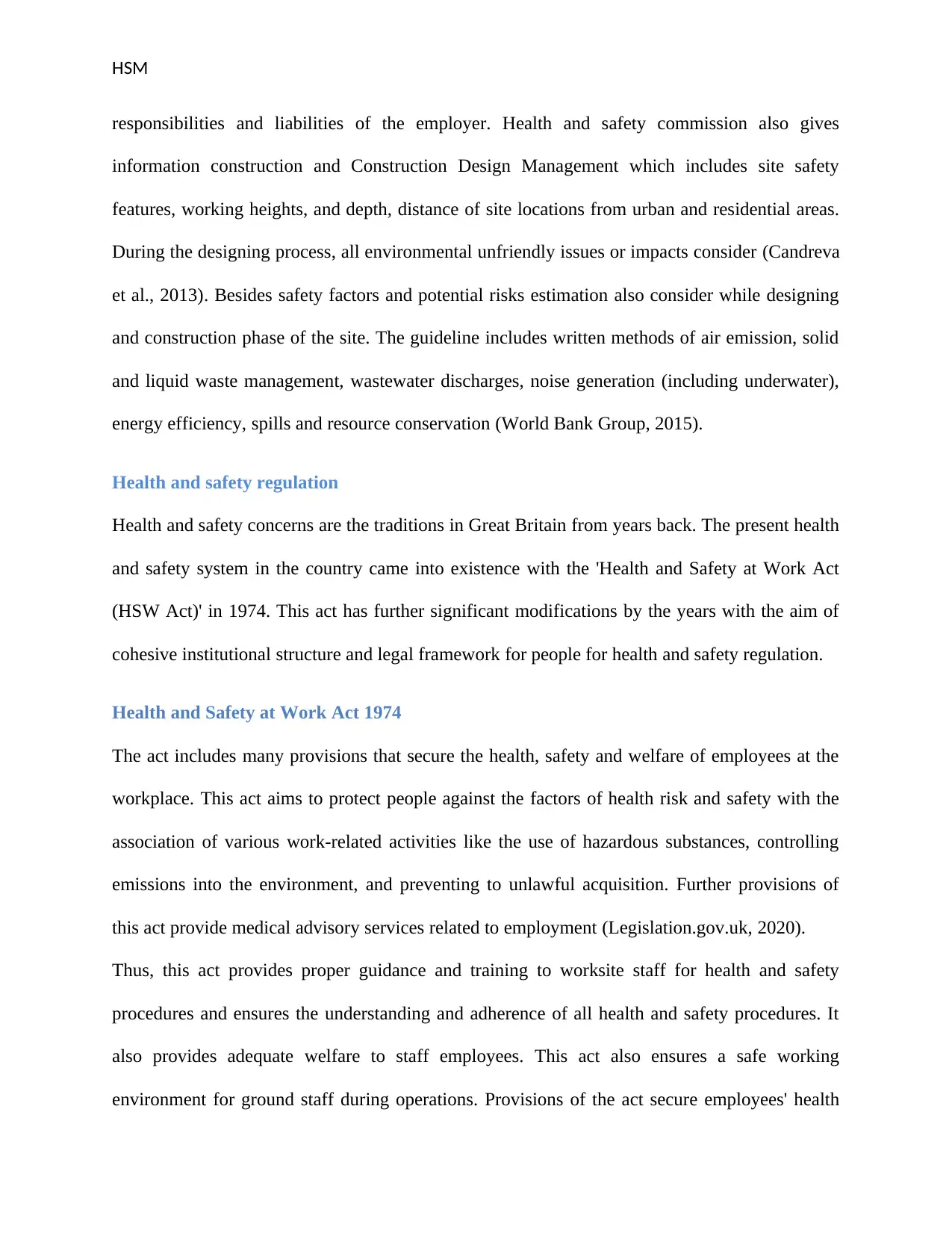
HSM
responsibilities and liabilities of the employer. Health and safety commission also gives
information construction and Construction Design Management which includes site safety
features, working heights, and depth, distance of site locations from urban and residential areas.
During the designing process, all environmental unfriendly issues or impacts consider (Candreva
et al., 2013). Besides safety factors and potential risks estimation also consider while designing
and construction phase of the site. The guideline includes written methods of air emission, solid
and liquid waste management, wastewater discharges, noise generation (including underwater),
energy efficiency, spills and resource conservation (World Bank Group, 2015).
Health and safety regulation
Health and safety concerns are the traditions in Great Britain from years back. The present health
and safety system in the country came into existence with the 'Health and Safety at Work Act
(HSW Act)' in 1974. This act has further significant modifications by the years with the aim of
cohesive institutional structure and legal framework for people for health and safety regulation.
Health and Safety at Work Act 1974
The act includes many provisions that secure the health, safety and welfare of employees at the
workplace. This act aims to protect people against the factors of health risk and safety with the
association of various work-related activities like the use of hazardous substances, controlling
emissions into the environment, and preventing to unlawful acquisition. Further provisions of
this act provide medical advisory services related to employment (Legislation.gov.uk, 2020).
Thus, this act provides proper guidance and training to worksite staff for health and safety
procedures and ensures the understanding and adherence of all health and safety procedures. It
also provides adequate welfare to staff employees. This act also ensures a safe working
environment for ground staff during operations. Provisions of the act secure employees' health
responsibilities and liabilities of the employer. Health and safety commission also gives
information construction and Construction Design Management which includes site safety
features, working heights, and depth, distance of site locations from urban and residential areas.
During the designing process, all environmental unfriendly issues or impacts consider (Candreva
et al., 2013). Besides safety factors and potential risks estimation also consider while designing
and construction phase of the site. The guideline includes written methods of air emission, solid
and liquid waste management, wastewater discharges, noise generation (including underwater),
energy efficiency, spills and resource conservation (World Bank Group, 2015).
Health and safety regulation
Health and safety concerns are the traditions in Great Britain from years back. The present health
and safety system in the country came into existence with the 'Health and Safety at Work Act
(HSW Act)' in 1974. This act has further significant modifications by the years with the aim of
cohesive institutional structure and legal framework for people for health and safety regulation.
Health and Safety at Work Act 1974
The act includes many provisions that secure the health, safety and welfare of employees at the
workplace. This act aims to protect people against the factors of health risk and safety with the
association of various work-related activities like the use of hazardous substances, controlling
emissions into the environment, and preventing to unlawful acquisition. Further provisions of
this act provide medical advisory services related to employment (Legislation.gov.uk, 2020).
Thus, this act provides proper guidance and training to worksite staff for health and safety
procedures and ensures the understanding and adherence of all health and safety procedures. It
also provides adequate welfare to staff employees. This act also ensures a safe working
environment for ground staff during operations. Provisions of the act secure employees' health
Paraphrase This Document
Need a fresh take? Get an instant paraphrase of this document with our AI Paraphraser
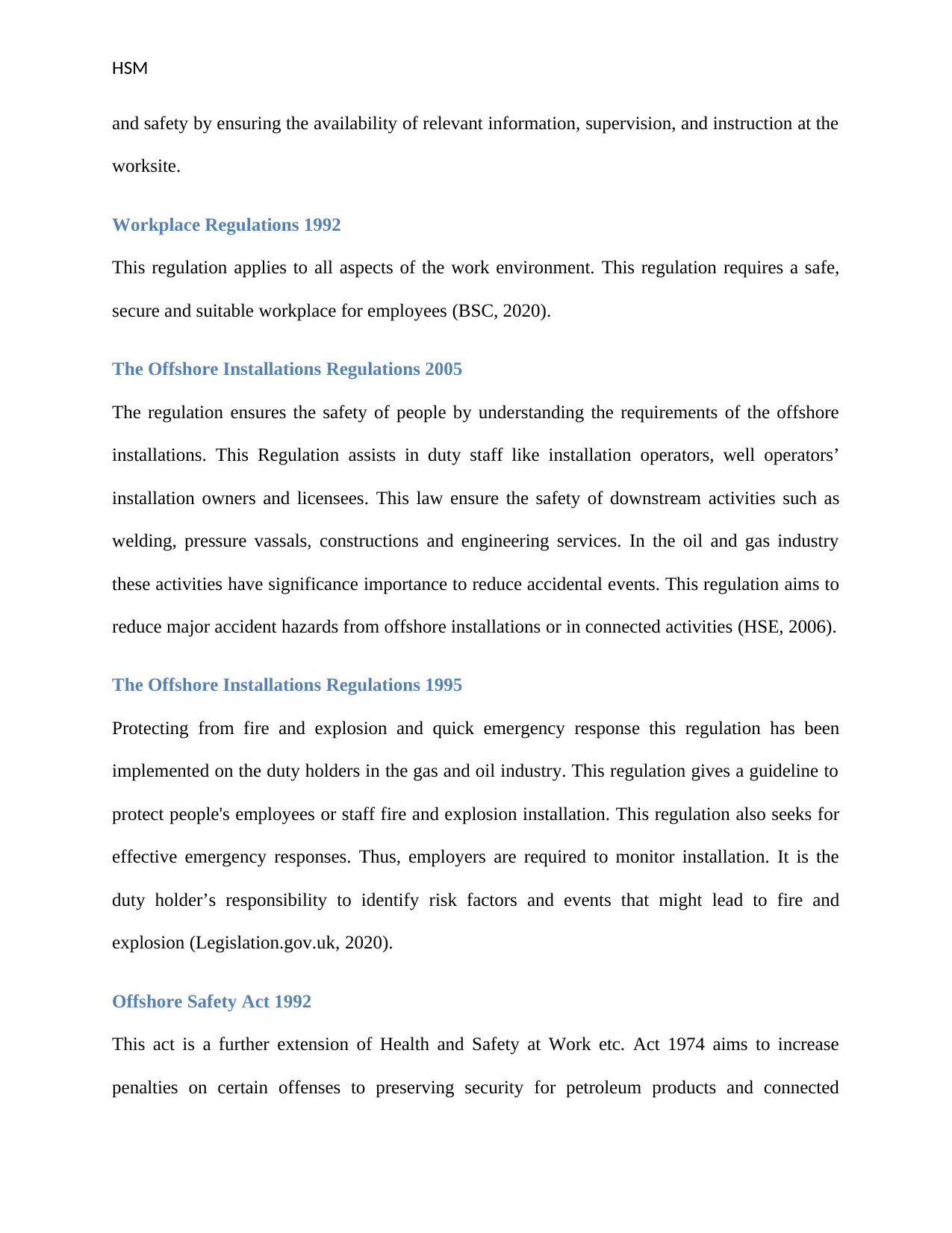
HSM
and safety by ensuring the availability of relevant information, supervision, and instruction at the
worksite.
Workplace Regulations 1992
This regulation applies to all aspects of the work environment. This regulation requires a safe,
secure and suitable workplace for employees (BSC, 2020).
The Offshore Installations Regulations 2005
The regulation ensures the safety of people by understanding the requirements of the offshore
installations. This Regulation assists in duty staff like installation operators, well operators’
installation owners and licensees. This law ensure the safety of downstream activities such as
welding, pressure vassals, constructions and engineering services. In the oil and gas industry
these activities have significance importance to reduce accidental events. This regulation aims to
reduce major accident hazards from offshore installations or in connected activities (HSE, 2006).
The Offshore Installations Regulations 1995
Protecting from fire and explosion and quick emergency response this regulation has been
implemented on the duty holders in the gas and oil industry. This regulation gives a guideline to
protect people's employees or staff fire and explosion installation. This regulation also seeks for
effective emergency responses. Thus, employers are required to monitor installation. It is the
duty holder’s responsibility to identify risk factors and events that might lead to fire and
explosion (Legislation.gov.uk, 2020).
Offshore Safety Act 1992
This act is a further extension of Health and Safety at Work etc. Act 1974 aims to increase
penalties on certain offenses to preserving security for petroleum products and connected
and safety by ensuring the availability of relevant information, supervision, and instruction at the
worksite.
Workplace Regulations 1992
This regulation applies to all aspects of the work environment. This regulation requires a safe,
secure and suitable workplace for employees (BSC, 2020).
The Offshore Installations Regulations 2005
The regulation ensures the safety of people by understanding the requirements of the offshore
installations. This Regulation assists in duty staff like installation operators, well operators’
installation owners and licensees. This law ensure the safety of downstream activities such as
welding, pressure vassals, constructions and engineering services. In the oil and gas industry
these activities have significance importance to reduce accidental events. This regulation aims to
reduce major accident hazards from offshore installations or in connected activities (HSE, 2006).
The Offshore Installations Regulations 1995
Protecting from fire and explosion and quick emergency response this regulation has been
implemented on the duty holders in the gas and oil industry. This regulation gives a guideline to
protect people's employees or staff fire and explosion installation. This regulation also seeks for
effective emergency responses. Thus, employers are required to monitor installation. It is the
duty holder’s responsibility to identify risk factors and events that might lead to fire and
explosion (Legislation.gov.uk, 2020).
Offshore Safety Act 1992
This act is a further extension of Health and Safety at Work etc. Act 1974 aims to increase
penalties on certain offenses to preserving security for petroleum products and connected
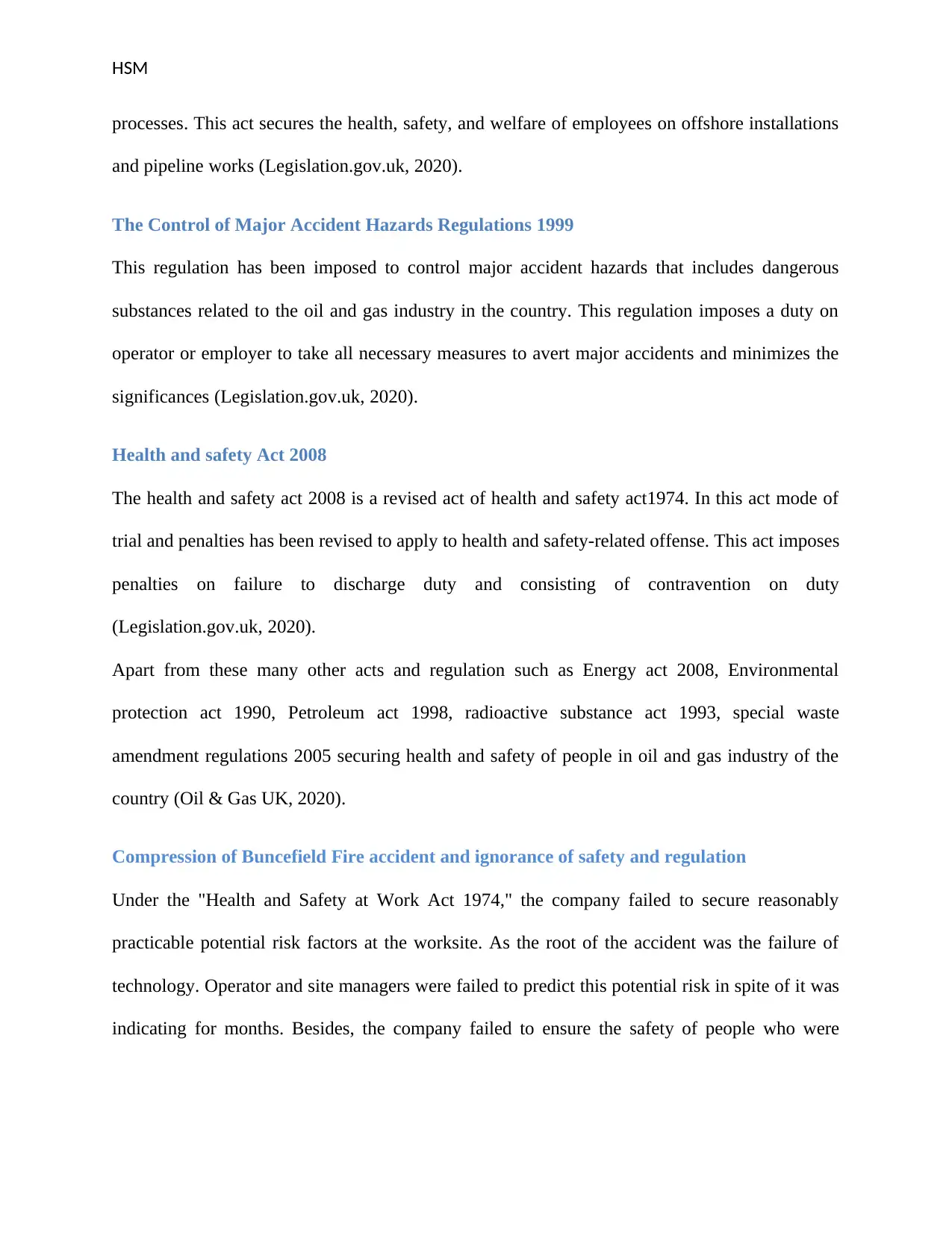
HSM
processes. This act secures the health, safety, and welfare of employees on offshore installations
and pipeline works (Legislation.gov.uk, 2020).
The Control of Major Accident Hazards Regulations 1999
This regulation has been imposed to control major accident hazards that includes dangerous
substances related to the oil and gas industry in the country. This regulation imposes a duty on
operator or employer to take all necessary measures to avert major accidents and minimizes the
significances (Legislation.gov.uk, 2020).
Health and safety Act 2008
The health and safety act 2008 is a revised act of health and safety act1974. In this act mode of
trial and penalties has been revised to apply to health and safety-related offense. This act imposes
penalties on failure to discharge duty and consisting of contravention on duty
(Legislation.gov.uk, 2020).
Apart from these many other acts and regulation such as Energy act 2008, Environmental
protection act 1990, Petroleum act 1998, radioactive substance act 1993, special waste
amendment regulations 2005 securing health and safety of people in oil and gas industry of the
country (Oil & Gas UK, 2020).
Compression of Buncefield Fire accident and ignorance of safety and regulation
Under the "Health and Safety at Work Act 1974," the company failed to secure reasonably
practicable potential risk factors at the worksite. As the root of the accident was the failure of
technology. Operator and site managers were failed to predict this potential risk in spite of it was
indicating for months. Besides, the company failed to ensure the safety of people who were
processes. This act secures the health, safety, and welfare of employees on offshore installations
and pipeline works (Legislation.gov.uk, 2020).
The Control of Major Accident Hazards Regulations 1999
This regulation has been imposed to control major accident hazards that includes dangerous
substances related to the oil and gas industry in the country. This regulation imposes a duty on
operator or employer to take all necessary measures to avert major accidents and minimizes the
significances (Legislation.gov.uk, 2020).
Health and safety Act 2008
The health and safety act 2008 is a revised act of health and safety act1974. In this act mode of
trial and penalties has been revised to apply to health and safety-related offense. This act imposes
penalties on failure to discharge duty and consisting of contravention on duty
(Legislation.gov.uk, 2020).
Apart from these many other acts and regulation such as Energy act 2008, Environmental
protection act 1990, Petroleum act 1998, radioactive substance act 1993, special waste
amendment regulations 2005 securing health and safety of people in oil and gas industry of the
country (Oil & Gas UK, 2020).
Compression of Buncefield Fire accident and ignorance of safety and regulation
Under the "Health and Safety at Work Act 1974," the company failed to secure reasonably
practicable potential risk factors at the worksite. As the root of the accident was the failure of
technology. Operator and site managers were failed to predict this potential risk in spite of it was
indicating for months. Besides, the company failed to ensure the safety of people who were
⊘ This is a preview!⊘
Do you want full access?
Subscribe today to unlock all pages.

Trusted by 1+ million students worldwide
1 out of 19
Related Documents
Your All-in-One AI-Powered Toolkit for Academic Success.
+13062052269
info@desklib.com
Available 24*7 on WhatsApp / Email
![[object Object]](/_next/static/media/star-bottom.7253800d.svg)
Unlock your academic potential
Copyright © 2020–2025 A2Z Services. All Rights Reserved. Developed and managed by ZUCOL.



